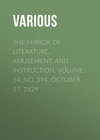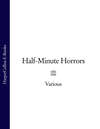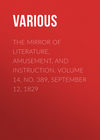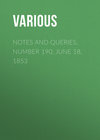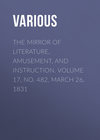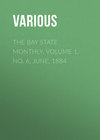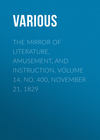Czytaj książkę: «The Mirror of Literature, Amusement, and Instruction. Volume 14, No. 394, October 17, 1829», strona 3
RETROSPECTIVE GLEANINGS
LETTER OF LORD STRAFFORD
(For the Mirror.)
The following is literally copied from an original autograph of the unfortunate Lord Strafford, and may prove interesting to your numerous readers.
C.J.T.
"Sweete Harte.—It is longe since I writt unto you, for I am here in such a troubel as gives mee little or noe respett. The chardge is now cum in, and I am now abel I prayse God, to telle you that I conceaue there is nothing capitall, and for the reste I knowe at the worste his maty will pardonne all without hurting my fortune, and then wee shall be happie by God's grace. Therefore comfortt yourself, for I trust these cloudes will away and thate wee shall have faire weathere afterwarde.
"Fare well, your lovinge husbande,
"Tower of Londonne,
"STRAFFORDE.
"4th Feb. 1640.
"My Wife."
STONE PILLARS AND CROSSES
(For the Mirror.)
It appears from the accounts of the earliest historians, that single stones, or rude pillars were raised on various occasions, in the most remote ages. Of these we have frequent notices in the Old Testament, as of that raised by Jacob at Lug, afterwards named Bethel; a pillar was also raised by him at the grave of Rachel. The Gentiles set up pillars for idolatrous purposes. The Paphians worshipped their Venus under the form of a white pyramid, and the Brachmans the great God under the figure of a little column of stone. Many large stones are found at this day in Wales and Cornwall, which are supposed to have been raised by the Phoenicians and Grecians, who frequently resorted thither for tin and other metals.
In Ireland some of these large stones have crosses cut on them, supposed to have been sculptured by Christians, out of compliance with Druidical prejudices, that the converts from Paganism not easily diverted from their reverence for these stones, might pay them a kind of justifiable adoration, when thus appropriated to the use of Christian memorials, by the sign of the Cross. Some signs of adoration are at this day paid to such stones, in the Scottish Western Isles; they are called bowing stones. In the Isle of Barra there is one about seven feet high, and when the inhabitants come near, they take a religious turn round it, according with ancient Druidical custom.
Stones were raised also as memorials of civil contracts; as by Jacob, in his contract with Laban, when the attendants of the latter raised a heap, to signify their assent to the treaty. Those conical, pyramidal, and cylindric stones, perpendicularly raised, which are seen in the British Isles, were formerly introduced in general, to ascertain the boundaries of districts. On these, representations of the crucifixion were frequently cut, and the name of crosses were given to the boundary stones in general, though remaining without this symbol. Many instances might be given of these termini. At High Cross, on the intersection of the Watling Street and Foss Roman roads, there was formerly a pillar which marked the limits of Warwickshire and Leicestershire—the present column is of modern date; another distinguished the boundaries of Asfordby and Frisby, in the latter county. One at Crowland, in the county of Lincoln, the inscription on which has caused considerable dispute amongst antiquarians, has been much noticed. A famous one near Landoris, in Fifeshire, placed, as Camden says, as a boundary between the districts of Fife and Stathern, was also a place of sanctuary.
Stone pillars, or crosses were also raised to record remarkable events; as where a battle had been fought, or over persons of distinction slain therein. Crosses were likewise erected where any particular instance of mercy had been shown by the Almighty, or where any person had been murdered by robbers, or had met with a violent death; where the corpse of any great person had rested on its way to interment, as those splendid ones erected by Edward I. in memory of his beloved Queen Elinor; often in churchyards, and in early times at most places of public concourse; in market-places, perhaps to repress all idea of undue gain or extortion; and at the meeting of four roads.
Penances were often finished at crosses. Near Stafford stood one called Weeping Cross, from its being a place designated for the expiation of penances, which concluded with weeping and other signs of contrition. A great number of sepulchral crosses were erected in Great Britain and Ireland, soon after prayers for the dead came into use, by the desire of individuals, at their places of interment, to remind pious people to pray for their souls.
The ancient practice of consecrating Pagan antiquities to religious purposes, has been continued to times comparatively modern; thus, Pope Sixtus V. purified the Antonine column and that of Trajan, dedicating them to St. Peter and St. Paul, whose statues, of a colossal size, he placed on their summits. Succeeding Popes followed these examples, dedicating ancient columns, pillars, and obelisks to different Saints and Apostles.
A CORRESPONDENT.
NOTES OF A READER
THE LONDON UNIVERSITY MAGAZINE, No. 1
It is seldom that we "turn critics;" but our very bile rises at the ill-timed dedication of this work to the King, as the "first fruits of the combined exertions of a few of your majesty's subjects, educated within the GROSSLY misrepresented UNIVERSITY of LONDON." It is quite unnecessary for us to explain why this Dedication deserves the epithet we have chosen: it stands with the signature of "the Proprietors," and we hope is not the act of the editors; but for the credit of the University, the publishers, the proprietors, and editors, we recommend their friends to cancel the leaf bearing this very offensive inscription, whether they care or not for the golden opinions of all sorts of people.
If the present Number be a fair sample of the London University Magazine, we can promise the reader but little amusement in our "Notes" from its pages. It may prove useful enough to the students of the University, but it wofully lacks the attractive features of a Magazine for the public; it may suit the library-table, but not the "excellent coffee room," or the "retired cigar room" of the University Hotel. "On a general Judgment—A new System of communicating Scientific Information in a Tabular form—On the Study of the Law and Medicine—On Apoplexy," and the general business of the University, are very grave matters for little more than 100 pages. "On the Metamorphosis of Plants," by Goethe, is more attractive; but Magazine readers do not want the lumber of law and medicine—the dry material of parchment, or the blood and filth of the physiological chair. How different too, is all this from the pleasantry and attic wit of "The Etonian," into whose volumes we still dip with undiminished gratification.
As we have enumerated the least attractive of the papers in the London University Magazine, we ought also to run over the lighter portions of its pages. These are "A young head, and, what is still better, a young heart,"—discursive enough—"A Tale of the Irish Rebellion—the Guerilla Bride, a Poem," beginning
"It is a tale of Spain—Romantic Spain!"
—and a Sketch of the Irish Exchequer Court. A description of the University, with a Vignette view, and ground plan, is perhaps, the most interesting of the whole Number; but as dramatic critics sometimes say of a new performer, we had rather see him in another character before we form an estimate of his talents—so we wait for better things from the London University Magazine.
THE EDINBURGH JOURNAL OF NATURAL AND GEOGRAPHICAL SCIENCE, No. 1
We expected much from the announcement of this work, and are not disappointed in its first Number. It contains original papers—scientific Reviews—geographical and natural History Collections—and an abundance of scientific intelligence—somewhat on the plan of Mr. Loudon's excellent Magazines. We have not at present room for extract; but the Number before us will furnish several interesting Notes for a portion of our next publication. A Tour in the Island of Jersey is one of the most amusing articles we have read for some time, and we hope to abridge it for our columns.
THE FOREIGN REVIEW
The Eighth Number of this valuable Journal is just published, and its table of contents is exceedingly attractive. Among these are Phrenology—a characteristic article on Germany—the French and Italian Drama—anecdotical papers on Napoleon and General Jackson and the United States of America, and the History of the Cid. Ours will be a pleasing task to "note" through this Number.
